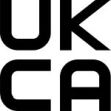In the guide
To fully understand this guidance, it is important to note the difference between the United Kingdom and Great Britain:
- UK: England, Scotland, Wales and Northern Ireland
- GB: England, Scotland and Wales
This guidance is for England, Scotland and Wales
There is a legal requirement for certain products to be UKCA-marked when placed on the internal GB market. UKCA marking is a key indicator of a product's compliance with GB legislation. By affixing the UKCA mark on a product a manufacturer is declaring conformity with all of the legal requirements to achieve UKCA marking. This may mean that there is more than one set of legal requirements that apply to a product.
For most products, the EU's CE mark can continue to be used instead of, or as well as, the UKCA mark.
UKCA mark
UKCA marking may be achieved in two different ways:
- examination by UK-approved bodies. This means that the manufacturer must use an approved body (such as those listed on the UKMCAB database) to test or review the product, which will enable the application of the UKCA mark
- self-declaration. This does not require any independent testing or review and it is therefore the manufacturer's own statement that they believe the product meets the relevant regulations

It is the manufacturer's responsibility to carry out the conformity assessment in accordance with the relevant safety legislation, bearing in mind that some safety legislation is product specific - for example, the Electrical Equipment (Safety) Regulations 2016 and the Toys (Safety) Regulations 2011.
It is also the manufacturer's responsibility to set up the technical file (including test reports and risk assessments), to issue the declaration of conformity and to affix the UKCA mark. There is no visual difference between a mandatory or self-declared UKCA mark, so a small business or consumer cannot tell whether the product has been tested or not. Therefore distributors must take care and must verify the presence of both the UKCA mark and the necessary supporting documentation.
If a product requires a UKCA mark but does not have one, it is illegal to place it on the GB market. However, do remember that not all products sold in GB need to bear UKCA marking, so distributors must have a basic knowledge of the legal requirements. You should know what products must bear the UKCA mark and the accompanying documents required, and should be able to identify products that are clearly not in compliance.
The GOV.UK website contains more detailed information on the UKCA mark, including guidance on roles and responsibilities, conformity assessment and documentation, and placing manufactured goods on the GB market.
Consumer products that must bear UKCA marking include:
- aerosols
- ecodesign - that is, energy consuming products such as air heating / cooling products, white goods, computers, lighting products, solid fuel boilers and transformers
- electrical goods designed or adapted for use between 50 and 1,000 volts (in the case of alternating current) and 75 and 1,500 volts (in the case of direct current); this covers domestic electrical equipment and equipment that is intended for use in the workplace. Also:
- electromagnetic capability for electric and electronic equipment
- electronic equipment that contains substances such as cadmium and mercury (restriction of hazardous substances - RoHS)
- equipment for use outdoors, particularly in relation to noise emissions
- gas appliances
- machinery
- medical devices such as thermometers, plasters and bandages, contact lens solutions, and pregnancy testing kits
- personal protective equipment such as sunglasses, protective gloves, goggles, protective clothing and helmets
- pyrotechnics - for example, fireworks
- radio equipment, which includes connected goods
- recreational craft and personal watercraft
- simple pressure vessels
- toys
CE mark
The CE mark is the equivalent of the UKCA mark in the European Economic Area (EEA). It was used in the UK until we left the EU.

For most products, the CE mark can continue to be used instead of, or as well as, the UKCA mark.
If you are an importer of certain goods from the EEA, under transitional arrangements you will be permitted to have your details applied via a sticky label or on accompanying documentation - rather than on the goods themselves - until 31 December 2027. There are different rules for products such as construction products and transportable pressure equipment.
Back to topUKNI mark
Where Northern Ireland is involved, there is a further mark that is used: the UKNI mark. This is needed because of the Northern Ireland Protocol, which came into force on 1 January 2021.

Guidance on the UKNI mark can be found on the GOV.UK website.
Back to topTrading Standards
For more information on the work of Trading Standards services - and the possible consequences of not abiding by the law - please see 'Trading Standards: powers, enforcement and penalties'.
Back to topIn this update
On 1 August 2023, the Government announced that for most products, the CE mark can continue to be used indefinitely. This follows the previous date of 31 December 2024, by which relevant products on sale in GB were to be required to use the UKCA mark.
Last reviewed / updated: August 2023
Back to topKey legislation
Product Safety and Metrology etc (Amendment etc) (EU Exit) Regulations 2019
Product Safety and Metrology etc (Amendment) Regulations 2021
Please note
This information is intended for guidance; only the courts can give an authoritative interpretation of the law.
The guide's 'Key legislation' links often only shows the original version of the legislation, although some amending legislation is linked to separately where it is directly related to the content of a guide. Information on changes to legislation can be found by following the above links and clicking on the 'More Resources' tab.

